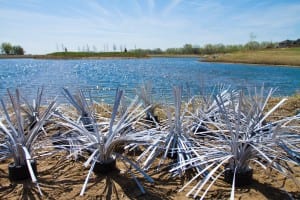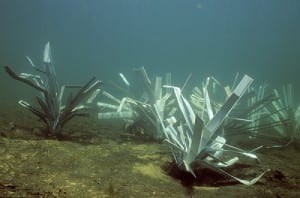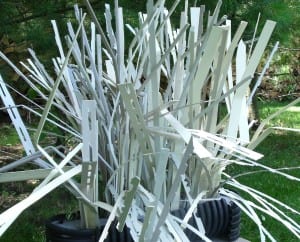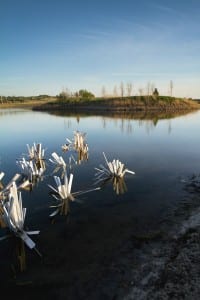For a long time, this half-mile stretch of river in Keene Valley was growing broader and shallower, filling with sediment and gravel as its banks eroded and fell in, eating the land of Rivermede Farm at a rate of several feet a year and losing habitat for fish, amphibians and reptiles.
Beginning in July, 2012, large trees were dug out of the ground nearby and imbedded in the riverbank, root wads facing into the stream as fish habitat, the trunks buried side by side to stabilize the bank.
Photo/Martha Allen/Lake Placid News
Carl Schwartz, of U.S. Fish & Wildlife Service, leads a tour of the recently completed Rivermede riverbank stabilization and restoration project on the east branch of the Ausable River in Keene Valley Thursday, Aug. 16.
“Fish, llittle minnows and bigger fish, appeared immediately, as soon as the habitat was restored,” said Corrie Miller, director of the Ausable River Association.
At the toe of the bank, underwater, where they will not decay, logs are buried, covered with a layer of woody debris and fill, live cuttings, and then a sod mat of jute or similar material, for the cuttings to grow through. This constitutes a bench, which deflects water currents, preventing scouring of the bank.
As plant life grows, it will stabilize the bank further. Every boulder, natural as it looks, was scientifically placed to maneuver the current just so, preventing scouring of the bank and moving the water, and sediment, in a way that benefits the river and its environs.
Riverbank stabilization experts used to think it was all about water dynamics.
“Now we know it’s also about sediment being moved and deposited,” Miller said.
Flood plain room is allowed for seasonal overflow of water and sediment; floods cannot be prevented, nor can they be contained or controlled with straight channeling.
“We want to make it look as if we were never here,” Schwartz said.
Miller said that willow shoots were planted to stabilize the bank, and started sprouting leaves right away. Willows root easily and quickly along a riverbank. More plantings will be made next spring, she said.
According to Braico and Schwartz, this design has a better chance of holding than older, less natural methods. Everyone concerned seemed to be crossing fingers that another major weather event will not take place before this restoration settles in and takes hold.
Thursday, Aug. 16, two days after completion, tours were held at the site to explain what had been done to restore natural riparian (riverbank) equilibrium. About 80 people attended the tours.
Rob Hastings, Rivermede farmer, who has contributed time and money to the effort over the years, was present. He expressed his happiness that the project is done and that the river looks so beautiful, as well as his hope that it will hold.
Instruction was given by John Braico of Trout Unlimited and Carl Schwartz of F&W. Corrie Miller, Director of the Ausable River Association, Tonnie Sauca, standing in for David Reckahn of Essex County Soil and Water Conservation District, and Martha Naley, of F&W, were also helpful in explaining the project and the science behind it to participants.
The Keene Town Board, represented by Councilman Paul Martin, presented Braico with a plaque in recognition of his years of service and extensive volunteer work on this project.
Former Keene Supervisor Tom Both, who presided over the early planning days of the “Rivermede Project,” praised Braico at the August town board meeting, stating that Braico has “devoted thousands of hours to this project over 15 years.”
In 1998, Trout Unlimited began initial studies of the problem.
The Army Corps of Engineers became involved with the project in 2005, then finally withdrew in 2012 because the town could not come up with sufficient funding for the Army Corps plan. That same month, Trout Unlimited approached U.s. Fish & Wildlife Service, asking to partner with them to do a different version of the stalled 15-year project within a modest budget.
Between July 14 and August 14, 2012, inside 23 work days, under the direction of US Fish & Wildlife Service and Trout Unlimited, Ward logging LLC, under Michael Ward, harvested and staged whole trees, logs and boulders from the Rivermede area and performed active construction. Seeding and mulching was done by TU, F&W and Essex County Soil and Water Conservation District.
There is no riprap at this site. All materials are from the neighborhood, following a healthy, natural river model. According to Trout Unlimited information, extreme floods are increasing in frequency, and methods including dredging, straightening, laterally confining, vertically entrenching and overwidening stream beds are unstable and can cause destruction to roads, bridges and buildings in major floods.
As an example, containment of the Ausable’s East Branch at its present width of 176′ would entail dredging to 19.4,’ according to TU statistics.
With unpredictable weather patterns that have been bringing frequent “100-year storms,” probably everyone in town is, like Rob Hastings of Rivermede, thankful and at the same time hoping it will work.
Funding for the project was provided primarily by The Adirondack Chapter of trout Unlimited, U. S. Fish & Wildlife Service and Essex County. Additional financial support was provided by Trout Unlimited of Tri Lakes, Lake Champlain and New York City, as well as Rivermede Farm, the town of Keene and the Ausable River Association.MARTHA ALLEN , Lake Placid News
See the dozens of unique habitat models at fishiding.com


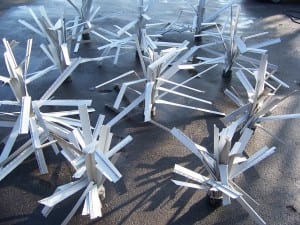
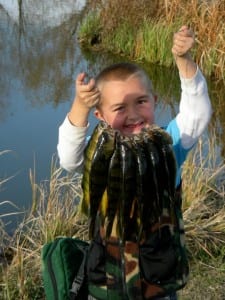

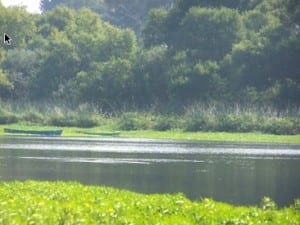
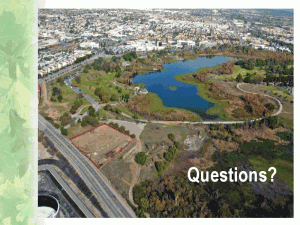
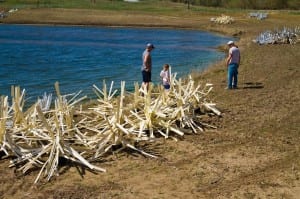
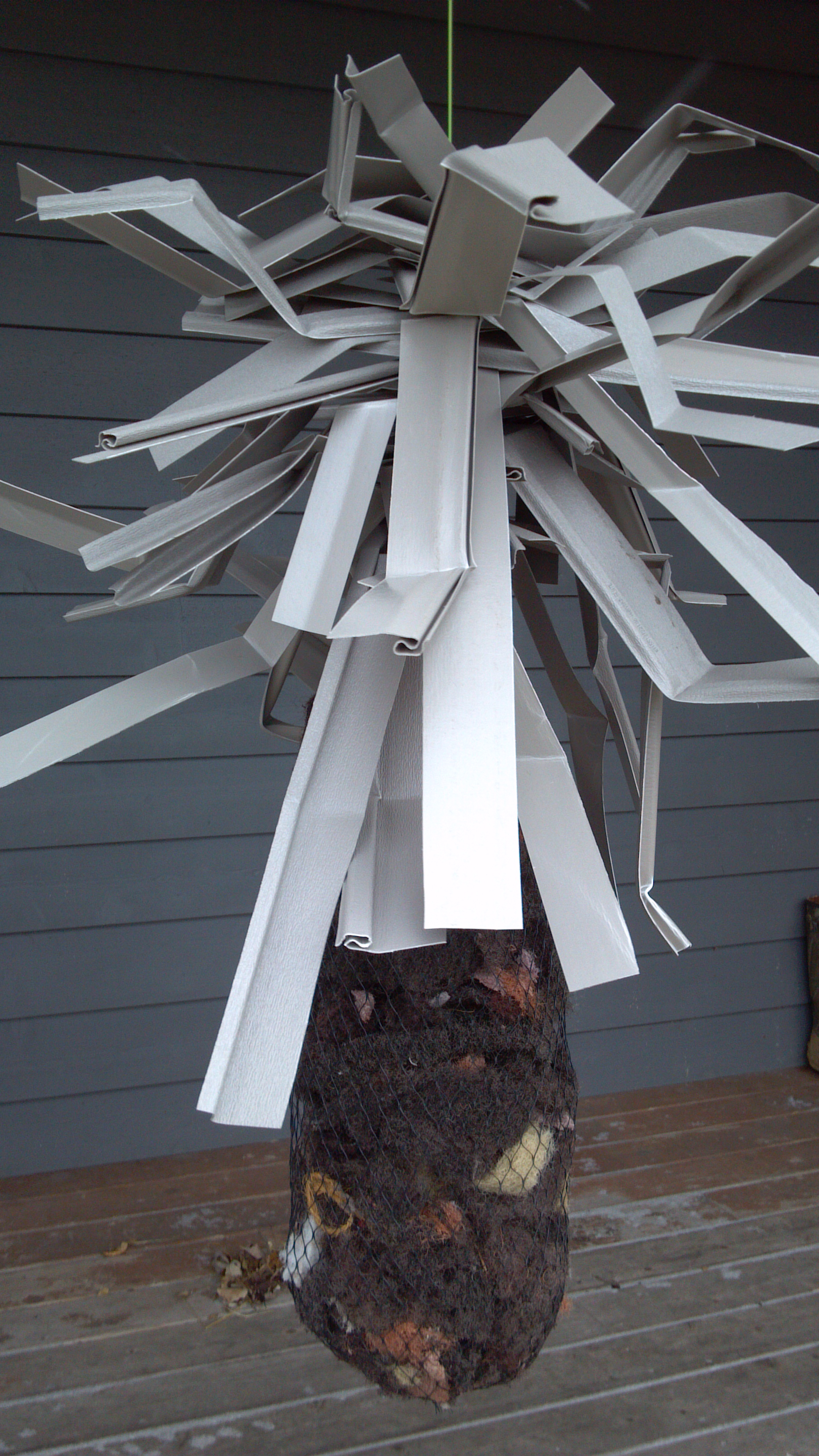

 The dam at Leaser Lake in Lynn Township has undergone major upgrading after the lake was drained for repairs. Man made fish habitats dot the interior of the lake bed. (Douglas Kilpatrick, SPECIAL TO THE MORNING CALL / February 12, 2012)
The dam at Leaser Lake in Lynn Township has undergone major upgrading after the lake was drained for repairs. Man made fish habitats dot the interior of the lake bed. (Douglas Kilpatrick, SPECIAL TO THE MORNING CALL / February 12, 2012)